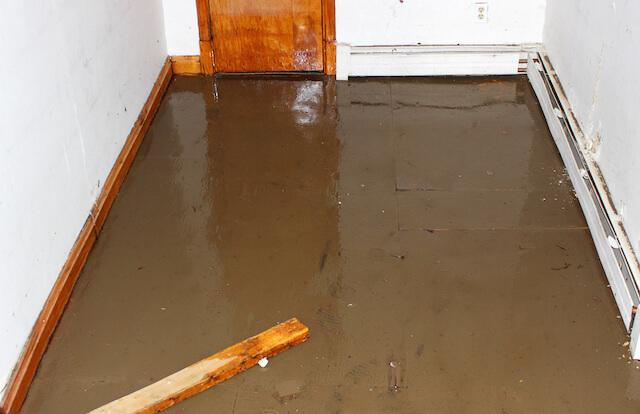How to Clean a Flooded Basement
When your basement is flooded, you need help fast. Read on for the right way to safely dry it out and fix the water damage.

There are many reasons for basement flooding and water damage, including burst pipes, poor drainage, sewage backups, and rising groundwater.
No matter how much water is in your basement, flooding can pose serious health and safety risks for you and your family. Taking action now can save you a lot of money on basement water damage repairs later. It's natural to panic when you find water in your basement, but safety should be your first priority.
There are several factors that can lead to basement flooding, such as weather events, burst pipes, and drainage issues. Whatever the cause and whether you're dealing with a flooded basement now or you simply want to be prepared, we have the tips you need to help you clean up after a flood.
6 immediate steps to take to clean up a flooded basement
If there's more than a couple inches of water in the basement, it's best to hire a professional who specializes in basement water damage restoration. If you have flood insurance, call your insurance provider to file a claim. If you’re only dealing with an inch or two of water, follow the steps below to clean up the flooding.
The water can contain harmful bacteria that are hazardous to your health. Once the source of the flooding has stopped or the water source has been turned off, follow these steps for cleaning the basement:
-
Turn off the power
Turn off the power before entering the basement. Call a qualified electrician if you aren’t able to access the circuit breaker.
-
Protect yourself
Flood water can contain hazardous materials, including raw sewage, chemicals, and pollutants. Regardless of the source of the water, put on waterproof boots, plastic or rubber gloves, and protective clothing before going into the basement. If you’re dealing with mold, FEMA recommends wearing gloves, goggles, and an N95 or N100 face mask that can be purchased at most hardware stores.
-
Dry out the basement
Start the cleanup by removing the water from the basement. Mold can form within just 48 hours so it’s important to act quickly. Depending on the amount of water, you might use a wet/dry vacuum or a sump pump to remove the water. With a wet/dry vacuum, it can take several trips to empty the canister and a lot of time to remove even just a couple of inches of water.
Once the standing water has been removed, place large fans to help speed up the drying process. Invest in a basement dehumidifier to remove additional moisture and prevent mold. A SaniDry from Basement Systems features automatic drainage and controls so you don’t have to worry about emptying buckets of water or adjusting the humidity level.
-
Remove wet furniture, belongings, and materials
Move any wet items out of the basement and allow them to dry in a well-ventilated area. Remove wet drywall and insulation. These materials grow mold quickly so it’s important to remove them as soon as possible. Also remove wet carpeting, which can prevent the floor underneath from drying. The National Electrical Manufacturers Association says to throw away items with electrical wiring, including outlets exposed to the flood water. Be sure to take photos of the damaged property for insurance purposes.
-
Clean walls, floor, and other surfaces
Wipe the walls and floor to remove any dirt left behind. After the home is dry and water-damaged items have been removed, surfaces can be cleaned with water and detergent, according to mold cleanup guidelines from the Environmental Protection Agency. In some cases, it’s best to hire a mold remediation professional to handle the mold cleanup.
-
Take steps to waterproof the basement
Any basement can flood. Add a sump pump and perimeter drainage system in the basement to protect against future flooding and water damage. Basement Systems offers several basement sump pumps, including a battery-powered pump that automatically pumps water out of the basement even in the event of a power outage. A local Basement Systems waterproofing professional can recommend the best sump pump system for your home’s needs.
If you live in a high-risk flood area, consider installing Smart Vent Foundation Flood Vents. The ICC-ES certified, engineered flood vents protect houses and buildings during floods by preventing hydrostatic pressure buildup that can destroy foundation walls. Contact Basement Systems to find out if there’s a Smart Vent dealer in your area.
Why did the basement flood?
Even after the cleanup is done, it’s important to know if the basement flood was caused by a one-time event or if it’s an ongoing water problem that needs to be addressed. You don’t want to store your family photos, antiques, and other irreplaceable items downstairs if there’s a chance it will flood again.
Flooding in your neighborhood and around your home is obvious. But you don’t have to live in a high-risk flood area or experience heavy rain for the basement to flood. There are other common sources of water in the basement:
- Water from failed plumbing, such as a burst pipe or broken water heater.
- Rainwater and groundwater seepage leaking through foundation walls.
- Water from saturated soil being pushed into the basement by hydrostatic pressure.
- Water backing up from a clogged floor drain.
- Water backing up from an overwhelmed municipal drain system.
If you're looking for more information on what you can do to reduce flood damage in your state or community, check out our list of Flood Resources for All 50 States. If your wet basement is a persistent problem, or if you need help determining the cause of your flooded basement, it's worth scheduling a free waterproofing evaluation and estimate with an experienced Basement Systems contractor.
